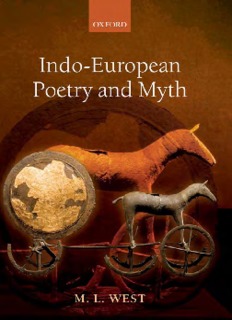‘Indo-European Poetry And Myt’ PDF Quick download link is given at the bottom of this article. You can see the PDF demo, size of the PDF, page numbers, and direct download Free PDF of ‘Indo-European Poetry And Myth PDF by M.L West’ using the download button.
Indo-European Poetry and Myth PDF Free Download

Chronological parameters
‘Indo-European’ is primarily a term of historical linguistics.
In Anatolia, from about 1650 BCE, we find the earliest attested Indo-European language, Hittite, together with two related languages, Luwian and Palaic.
The personal names attested in Assyrian traders’ records from Kiiltepe (the ancient Kanesh, 20 km. north-east of Kayseri) show that the dominant population of that area was already Hittite at the beginning of the second millennium and that Hittite already had a distinct profile separating it from Luwian.
Clearly, these Indo-European peoples were well established in Anatolia before 2000 BCE. But they were hardly autochthonous, for there were also many non-Indo-European speakers in the land. The native language of the central region was Hattic, which is thought to have Caucasian affinities.
Further east there was a solid front of non-Indo-European languages, Hurrian and Semitic. It was in the west and south of Anatolia that the languages of the Indo-European group prevailed.
This geographical distribution points strongly to the Indo-European speakers’ having entered the country not from the east via the Caucasus, but from the west, from the Balkans, as the Phrygians and Galatians did in later times.’
It refers to the great family of languages that now extends across every continent and already two thousand years ago extended across the whole breadth of
Europe and large tracts of central and southern Asia; or it refers to the hypothetical ancestral language from which all the recorded Indo-European languages descend.
That affinities existed among various of these languages, including Persian and Sanskrit, was often observed from the sixteenth century on.
In the seventeenth, the idea emerged of an extinct parent language, generally identified as ‘Scythian‘ or ‘Japhetic‘, as the source of the historical tongues.
The scientific study of linguistic relationships began early in the nineteenth century, pioneered by scholars with monosyllabic names such as Rask, Bopp, Grimm, and Pott.
It was at this time that the terms ‘Indo-Germanic and “Indo-European was coined; they were first recorded in 1810 and 1813 respectively.
The two centuries since then have seen steady advances in knowledge and understanding, and the progress achieved is now cumulatively enormous.
All serious students operate on the assumption of a single-parent language as the historical source of all the known Indo-European languages. This is still a hypothesis, not an observable fact, but it is an inescapable hypothesis.
Of course, when this Proto-Indo-European was spoken, it was itself only one of many languages that existed at that time, and it was no doubt related to some of the others.
Some scholars argue for affinities with Semitic, Caucasian, and Uralian, and gather all of these, together with Indo-European, into a super-family dubbed ‘Nostratic’.
This shimmering construct is of no consequence for the present study. But it is good to bear in mind that Indo-European was not a unique, original entity like the primal cosmic atom before the Big Bang.
| Writer | M L West |
| Language | English |
| Pages | 540 |
| Pdf Size | 2.22 MB |
| Category | Poetry |
Indo-European Poetry and Myth Book Pdf Free Download
Best Contemporary Poetry For Youth PDF
100+ The World’s Best Poetry PDF
Hafiz And The Religion of Love In Classical Persian Poetry PDF
